- Home
- Gary Vaynerchuk
Crushing It! EPB Page 2
Crushing It! EPB Read online
Page 2
I cannot do anything to make you more creative, but I hope that I can put you in the right frame of mind so that when you’re ready to unleash that creativity, you will succeed. We are often told we have to make a choice—settle and do something tolerable to make money, or follow our passion with the expectation that we will be poor. There are still people out there who believe that it’s a rare person who loves his or her job. That’s bullshit. Our choices are infinite when we understand today’s digital environment, as are our opportunities. We just have to find the courage to reach out and make them. You’re going to hear the stories of people who were scared, just like you. Who had obligations, just like you. Who were told they were being foolish, or reckless, or irresponsible, or immature. They did it anyway and reaped the rewards. If there’s anything this book should teach you, it’s that the only thing stopping you from achieving lasting career and life happiness is you.
I
Get Pumped
1
The Path Is All Yours
An entrepreneur is someone who finds a way.
—Shaun “Shonduras” McBride
The promise of my first business book, Crush It!, was to teach entrepreneurs how to monetize their passion by using social media to build a strong personal brand to attract customers and advertisers to their websites, as well as transform them into such trusted experts or entertainment figures that brands and outlets would pay them to talk, consult, and attend events. In other words, it was all about building a personal brand around your business strong enough to make you an influencer. And yet the word influencer doesn’t appear once. The multibillion-dollar influencer marketing industry was still so new at the time, the concept hadn’t crystallized when that book was published in 2009. Yet today, influencer marketing is poised to eat a real chunk of traditional marketing’s lunch. Younger consumers spend increasingly less time on traditional media and more time consuming content online.
YouTube’s daily viewership is closing in on TV’s 1.25 billion hours per day, as television viewership falls every year.1
One in every five minutes spent on mobile is spent on Facebook’s apps and services.2
Every minute, 65,900 videos and photos are posted on Instagram.3
Over 3 billion snaps are created each day on Snapchat, where over 60 percent of ads are watched with the audio on.4
Consequently, since 2009, brands have tripled the amount of money they spend on social media.5 With the explosion in the number of social networks available to anyone who wants to amass an audience, and vast sums of money being redirected toward those networks, influencer marketing has become a legitimate monetization strategy for anyone building an online profile, which means pretty much anyone in business.
How legitimate? The top-grossing YouTubers earned a combined $70 million in 2016. Many fit a certain type—several are gamer dudes, for example—but Lilly Singh is a rapper-comedian who features Punjabi culture in her videos, Rosanna Pansino is a baker, and Tyler Oakley is an LGBTQ activist.6 In the past, the top-grossing list has also included dancing violinist Lindsey Stirling and makeup artist Michelle Phan.7 The most popular Instagrammers can earn seven figures per year from their social-media efforts alone. Even with only a thousand followers, an entry-level Instagrammer could earn about $5,000 per year with just two posts a week, and ten thousand followers could net almost $20,000 per year.8 Again, that’s with just two posts per week; imagine the earnings if that Instagrammer posted more frequently. Let’s think about that. The median salary for US employees is about $51,000.9 You can earn that as an office manager, or you can earn the same amount running your own business built around something you love more than anything else in the world. Want to play it safe? You can work as an office manager, go home, and then earn an extra $10,000 a year on Twitch letting people watch you play and comment on your favorite video game, because you really are that good at it. Or use YouTube to share insanely cool science experiments. Or post pictures on Instagram of your pet hedgehogs wearing tiny hats. Thanks to the proliferation of platforms and the migration of TV and magazine viewers to the Internet, there is room for many, many more experts and personalities to create a lucrative, sustainable ecosystem that promotes and grows their businesses or even side hustles.
It’s a great time to be a fashion model, for example. There was a time when there was room for only a handful of superstars to see themselves featured in editorial fashion spreads and on the runways. Then there were maybe a thousand in the middle getting steady commercial work in print and TV. The rest found themselves at the bottom, scraping by doing catalog and promotional work. But the Internet has opened a floodgate of opportunity for anyone willing to hustle to grow a fan base through blogs and video channels to attract the attention of the hundreds of thousands of brands eager to spend money supporting popular, good-looking, fashionable people by branded content and advertising. Not only that, people blessed with model good looks—or even just blessed with angle and filter savvy—don’t actually have to model to get paid. The huge shift in attention to social media means that beautiful people are no longer beholden to the magazines or talent agencies or anyone, really, to make money off their looks. They can look fabulous every day on their own platforms while engaging with a steadily growing audience, and brands will come begging for exposure. Just ask Brittany Xavier (see Chapter 13).
We often define an influencer as someone who garners such a big audience on social media that brands offer to pay that person to attend events, take selfies with products, or talk about services. Brands have paid the famous people of the Internet billions of dollars to be their endorsers, sponsors, promoters, and product placers. Product placement is a natural fit with the YouTube and Instagram crowd, but it can leave the motorcycle-king bloggers or raspberry-jam-queen podcasters—those who might not feel photogenic or charismatic enough for constant selfies or video—feeling as if their options for growing their influence and building revenue streams are limited to selling ad space. I’m here to tell you, they are not. You just have to be smart and strategic about how you use your content. Look, I’ve been paid to write books and speak on national and international stages, and I’ve earned enough to make the kind of investments that could pay out for generations. However, I have not made one penny because an energy drink company paid me to say, “This is my secret to working eighteen hours a day.”
I’m an entrepreneur who built a $150 million media company in part because of my personal brand, which I developed by first creating valuable content that grew my influence. That’s one way to crush it. By all means, though, go ahead and make money over time by running ads, for example by selling ad space to a candy bar company. As your star rises, you could get paid $10,000 for placing a candy bar on your table while you work. But for God’s sake, don’t stop there. That’s where you start. Don’t leave money on the table because you don’t realize how much bigger you can get. How big? The Internet is an entrepreneur’s oyster, and you can use its pearly platforms to build a personal brand so powerful that the world is not only willing to pay you for your products or services or to promote other people’s products and services, but also it might even be willing to pay you to just be you. To me, that is when you’ve become a true influencer. At its height, influencer marketing is reality TV 2.0. I want you to think of yourself as tomorrow’s newest star.
You the entrepreneur are no different from the organic mac-and-cheese brand that branches out into cheddar cheese crackers and chicken noodle soup. The brand was never about organic mac and cheese; it was about organic comfort food. You’re the expectant mom who starts a pregnancy podcast and then writes a book on raising kids suffering from anxiety. You’re the home cook with a beautiful Instagram stream who starts a podcast on canning and gets invited to write a column about urban gardening in a national magazine. You’re the boy who started a wine blog that wasn’t actually about wine but about making a name for himself as the person who could show other businesses better ways to communicate and
sell. The home cook’s Instagram isn’t about food but about building her influence in the healthy-lifestyle category. The mom’s podcast on pregnancy is just the patty of a parenthood burger.
Your personal brand can get you all the fixings you want. Its outsize importance in today’s business world means stardom is no longer limited to the most beautiful or telegenic among us; the field is open to many, many more players. It also means that most entrepreneurs still have lots of room to ratchet up their game to become influencers. I’m watching you out there, and it’s shocking to me how many entrepreneurs trap themselves into boxes of their own making, even though they have so much more power than they did before.
Let’s say you’re killing it on Twitter. What are you going to do the day you realize you’re tired of Twitter? What are you going to do if Twitter disappears? What if you’re the country’s favorite beekeeper and you develop a deadly allergy to bees? It’s a matter of survival to think beyond your current successes and constantly look for ways to create new ones so that you’re never limited to any one platform or even one topic. How do you do that? By creating a personal brand so powerful that it transcends platforms, products, and even your passion.
Take cultural icon Julie Andrews,* the rosy-cheeked star of multiple Broadway and Hollywood masterpieces like Camelot, The Sound of Music, and Mary Poppins. Her entire career—her entire identity—was built on the soaring soprano voice that made her a household name. “I thought . . . my voice was what I am.”10 Then about twenty years ago, she had surgery to remove precancerous cysts on her vocal cords. When she awoke, the cysts were gone, but so was her voice. But because she was Julie Andrews, that wasn’t the end of her career. She has since written dozens of children’s books, starred in the blockbuster movie series The Princess Diaries, and most recently, in conjunction with Jim Henson Company, produced and starred in a Netflix series that teaches arts appreciation to preschoolers.
Oprah was not just a talk show host. Muhammad Ali was not just a boxer. The Rock is not just a wrestler. A strong personal brand is your ticket to complete personal and professional freedom. I want you to become the Julie Andrews or Muhammad Ali of your industry. Of course, for this to work, you have to start with phenomenal talent. Unlike these celebrities, though, you won’t need an agent to get you noticed by the right people and start making better money. In 2009, a comedian who amassed thousands of followers cracking jokes on Twitter started making real money only when she got signed by Creative Artists Agency and landed a “real job” writing jokes for David Letterman. Today, however, you don’t need to write jokes for other people when the maker of M&M’s, Mars, could pay you $10,000 to tweet your own M&M joke. And you don’t need to sell your material to a television network to land a lucrative deal. Let’s remember that back in 2009, people still used their phones as phones. We were still using flip cams to film our videos, and our phones hadn’t metamorphosed into our televisions and movie screens. That’s all changed. The Internet became the ultimate middleman, allowing every industry to go direct-to-consumer, from music and publishing to taxis and hotels. Snapchat, Instagram, and Facebook are the NBC, ABC, and CBS of our day. Your audience is waiting for you. What you need to do is figure out how you’re going to become the next Empire.
In 2009, I was trying to get you to understand that you could make some money in the online world or use it to catapult yourself to the mainstream if that was your end goal. Today, the Internet is the mainstream. You are in complete control of how the world sees you, how often, and in what context. Social-media phenom John “The Fat Jewish” Ostrovsky had been on the entertainment circuit for years, signing with a record label in college and hosting a celebrity interview show on E!, but it wasn’t until he amassed half a million followers on Instagram that he was able to parlay his comedy and performance art into a book deal, a wine label, and appearances on reality TV (which led to his gaining ten million followers on Instagram). Superstar filmmaker Casey Neistat started making online films as far back as 2003, but it was the high-quality short films and creative daily vlog he posted on YouTube that cemented his personal brand in the minds and hearts of eight million followers. With that audience, he was able to sell his company to CNN for $25 million, launch a new project there that aims to bridge “the gigantic divide” between his young-skewing audience and the mainstream news media,11 and become the face of a Samsung commercial that aired during the 2017 Oscars.
Personal Brands Are for Everyone
Strategically developing a personal brand through social media works brilliantly for creatives, as proven by the high number of photographers, artists, and musicians who offered to share their stories for this book when I put the call out for submissions. However, it can work for anyone in any industry who wants to put in the hustle. You no longer have to toil incognito behind someone else’s name or logo until you build enough cred to strike out on your own. Of course you can, and many do, often to build up their knowledge, life experience, and savings accounts before taking that entrepreneurial leap. Several of the people interviewed for this book said that the experiences and skills they gained in their former jobs—even the ones they hated—were essential to helping them become the entrepreneurs they are today. Take, for instance, Dan Markham, who cohosts YouTube’s What’s Inside? channel with his son, Lincoln.
As a sales rep, oddly enough, learning how to convince doctors to use certain drugs taught me how to be a YouTuber. I would practice with the other representatives. We’d practice and practice and practice and practice. I’d never been on camera before, but I feel like the camera is just like talking to one of those other drug reps or in front of the doctor. And so, my job actually helped me. I knew I wanted to be an entrepreneur, I knew I wanted to own my own business. But I was working so hard going to college and going to my day job and learning all I could from being a sales rep. And then doing all the little things on the side. And failing and succeeding. And then finally, it just kind of came together.
I’m thirty-seven, and I’ve been working on this since I was nineteen years old, trying to develop myself. It took all of those years for it to happen. But now I feel like I’m finally at a place where I wanted to be. It’s crazy that this is where it is, but I love it.
Isn’t it cool to know there is no prescribed route? If you’re a project manager who’d rather be a beekeeper, for example, tomorrow—yes, tomorrow—you could launch a nature-oriented podcast and blog with perceptive, humorous, creative content, and amplify your voice in all kinds of arenas beyond bees. Then you could start producing how-to videos or write a book about starting in the biz, ensuring that your knowledge is passed on to the new generation of beekeepers. You’d be sharing important information and growing your personal brand at the same time. And then, you could be asked to host a special on Animal Planet, or National Geographic could call and say they want to do a feature. As your personal brand grows, you might develop a recipe for a new honey-flavored candy, lip balm, lozenge, or yogurt. You might create a new bug spray or skin regimen, or design bee-branded tote bags and gardening materials. Or you may get a direct message on Instagram from fashion model Karlie Kloss, who, it turns out, is super into bee culture, and the tagged selfie you take together not only boosts your book sales from three hundred to thirty thousand, but also it sparks the next chapter of your career. That shit is really happening. Use today’s social-media platforms to develop your brand and expand your influence, and you can build a business that could continue to grow even if you never touched another hive.
That’s just a hypothetical example, but you’ll read lots of real ones in the following chapters. This book is a celebration of all the people who have put the Crush It! principles to work and seen massive success in return. I want you to learn from their examples. Some represented here are my friends; many are just random people who, when given the chance, stepped up to share with you how they did it. It was nearly impossible to choose from among the inspiring stories we heard, and I wish we could have featur
ed everyone who reached out to me and my staff. There just wasn’t room.* We heard great stories from entertainers, fitness professionals, fashion bloggers, and of course, marketing consultants—people you might expect to be crushing it on social media—but we also heard from a dentist, a financial planner, a dog trainer, a LEGO convention planner, and a quick-lube oil-change business owner, among scores of others. Many started out young and single, but some already had kids when they decided to double down and crush it. Several gave up lucrative jobs to devote themselves to their passion. What this should tell you is that if you’re not crushing it, it’s not because you’re too old or poor or have too many other responsibilities. It’s because you haven’t fully committed to making the leap yet. You’re making excuses, like, “Gary makes it seem so easy, yet this is really almost impossible.” It’s not, actually, but you can’t half-ass this. It will require big risks. It will take all your mental capacity, your time, and your leisure. You’re going to eat shit for a long time, but I promise, the sacrifices will be worthwhile. I also promise that once you’ve developed a robust personal brand, you will be able to enjoy as much or as little leisure as you want—because you will be entirely in control of your own life.
Don’t look for a nine-step program to success here, though. I can’t give you one. The principles are universal; the path is all yours. I will give you examples of how to use the platforms, as will the people who shared their stories with us. But they’re just examples, not commands. You can do it my way, or you can do it your way. Chart your path in the spirit of Crush It!, if not by the letter. You just have to make the choice to actually do it. I am so tired of excuses. Why not try something new? Be optimistic, exhibit patience, shut your mouth, and execute.

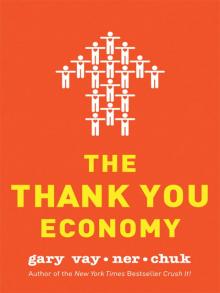 The Thank You Economy
The Thank You Economy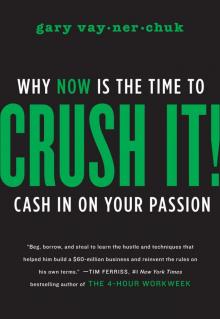 Crush It!
Crush It!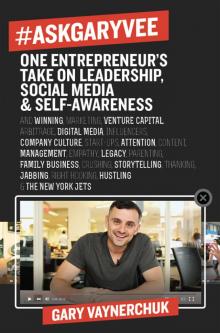 #AskGaryVee
#AskGaryVee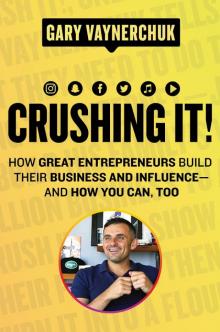 Crushing It! EPB
Crushing It! EPB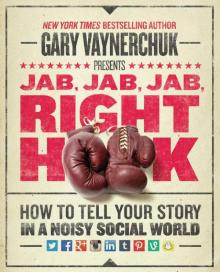 Jab, Jab, Jab, Right Hook
Jab, Jab, Jab, Right Hook